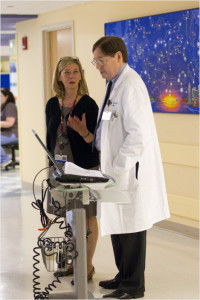 Medical errors are a leading cause of death and injury in America, and an estimated 80 percent of serious medical errors involve some form of miscommunication, particularly during the transfer of care from one provider to the next. However, a study published this week in the Journal of the American Medical Association demonstrates that standardizing written and verbal communication during these patient “handoffs” can substantially reduce medical errors without burdening existing workflows.
Medical errors are a leading cause of death and injury in America, and an estimated 80 percent of serious medical errors involve some form of miscommunication, particularly during the transfer of care from one provider to the next. However, a study published this week in the Journal of the American Medical Association demonstrates that standardizing written and verbal communication during these patient “handoffs” can substantially reduce medical errors without burdening existing workflows.
The study followed 1,255 patient admissions to two separate inpatient units at Boston Children’s Hospital—half occurring before a new verbal and written handoff program was introduced (July to September 2009) and half after (from November 2009 to January 2010).
After implementation, providers spent more time communicating face-to-face in quiet areas conducive to conversation. There were fewer omissions or miscommunications about patient data during handoffs. And medical errors decreased 45.8 percent. Most errors caused no harm or were later intercepted, but the most serious category—preventable adverse events—decreased from 3.3 to 1.5 per 100 admissions, a 54.5 percent drop.
“We believe if other medical centers adopted similar protocols it could have a positive and significant impact on patient safety,” says Christopher Landrigan, MD, MPH, the study’s principal investigator.
Bundled handoff system
Although handoff practices have become more standardized in recent years, medical errors due to provider miscommunication continue to be a serious issue. And as hospital workers’ shifts become shorter—first-year residents are now forbidden to work more than 16 hours per shift, about 14 hours fewer than the previous generation—patient handoffs happen more often, presenting more opportunities for miscommunication and error.
“We believed these systems would lead to a reduction in medical errors, but didn’t expect to see a change of this magnitude. Even more surprising was that the systems were introduced so easily.”
“Doctors are traditionally taught how to interview a patient and how to write daily notes summarizing the plan of care, but rarely receive communication or handoff training in medical school, even though proper communication among providers is vital to patient care,” says Boston Children’s researcher Amy Starmer, MD, MPH, lead author on the study. “We wanted to rectify that omission in some way.”
The handoff protocol involved a multi-faceted “communication bundle” meant for an entire hospital to implement. To begin, participating clinicians attended an interactive workshop where they practiced giving and receiving handoffs under different clinical and real-world scenarios. (The workshop was based on best practices for handoffs using elements of the TeamSTEPPS communication program, developed by the military and the U.S. Agency for Healthcare Research and Quality.)
Secondly, participants adopted an easy-to-remember mnemonic to ensure all relevant information was verbally passed on during handoffs. Face-to-face handoffs were restructured to involve all team members and minimize interruptions and distractions.
Finally, in conjunction with a Boston Children’s informatics team, the researchers created a structured tool to document patient information in written form. The forms, integrating with electronic medical record (EMR) systems, self-populated with standard patient information that previously had to be entered and re-entered manually in a word processing document, thus reducing the chances of error. The new tool also prompted users to make sure all important information had been entered, acting as a final safety net.
“We believed these systems would lead to a reduction in medical errors, but didn’t expect to see a change of this magnitude,” Starmer says. “And even more surprising was that the systems were introduced so easily.”
The protocol had another benefit: Providers spent more time at the bedside with patients.
Moving forward
Given the success that standardized communication brought to Boston Children’s, Starmer, Landrigan and colleagues went on to develop what’s now known as the I-PASS Handoff Program, which is now being studied in nine hospitals across the U.S. and Canada.
Similar to the communication bundle used in their initial study, the I-PASS program includes a novel mnemonic to standardize the verbal and written handoff process:
I – Illness severity
P – Patient summary (the standard clinical summary)
A – Action list for the next team
S – Situation awareness/contingency plans (The “what if” plan. As in, “if the patient begins to X, the best course of action would be Y.”)
S – Synthesis (a chance for a “read-back” of the information by the provider being briefed, which helps ensure that all parties are on the same page)
“I-PASS has brought together medical educators, hospitalists and health services researchers from across North America to develop a robust handoff bundle that can be broadly disseminated, without impacting previously existing workflows,” says Landrigan.
“We feared forcing people to learn a new way of doing things could interfere with care providers’ work, but we found the opposite to be true” adds Starmer. “Users actually became more productive and could then focus more energy on the job at hand.”







